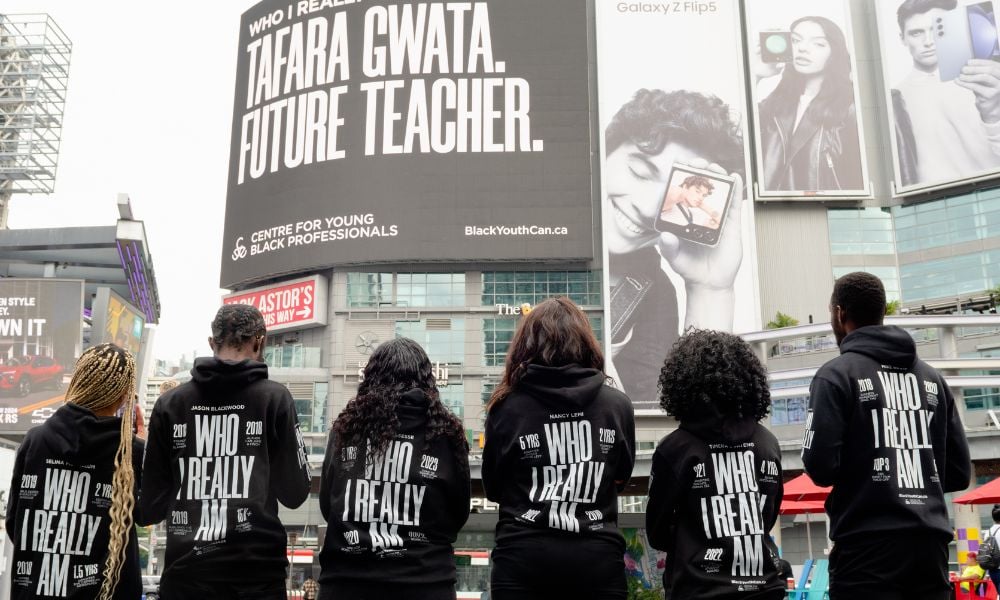Push to 'reclaim the hoodie' shines light on need 'to get past hiring bias'

“I often say the biggest challenge we have is for us to undo the lie that’s been told to our young people about them.”
So says Agapi Gessesse, executive director of the CEE Centre for Young Black Professionals in Toronto, which recently launched a campaign to help this often marginalized group gain meaningful employment.
With the brand platform Black Youth Can and the slogan “Who I Really Am,” the campaign aims to combat the sometimes negative perception of how some young Black persons dress — such as wearing a hoodie, says Gessesse.
“Young people wearing it looking like they’re intimidating, looking like they’re up to no good but really what we’ve done is taken that hoodie and created a resume of all of the brilliant accomplishments that our young people have been able to do and put it on a resume on a hoodie, like written in ink.”
The advertising effort, run in partnership with Publicis Groupe, focuses on the stories of nine Black professionals who have successfully gone through CEE’s training programs. The images are presented on billboards in prominent locations in Toronto.
“There’s campaign across the entire city of Toronto. It’s plastered all over Union Station, Dundas Square with these profiles of our alumni who’ve gone through our programs, really showing the world who they really are — and they’re not who you think they are,” says Gessesse.
“They actually are folks who are going to do their Masters, they’re university students, they’re filmmakers, they’re accountants and so we really wanted to showcase their stories so that people can see what they can contribute to the Canadian economy.”
Many organizations have talked about expanding DEI initiatives in the wake of George Floyd’s murder but few have followed through, according to recent research.
Looking for sponsorship help
While the campaign runs for six weeks, CEE is hoping to build upon it in subsequent years, according to Gessesse.
“We’re looking for corporate sponsorship folks to come alongside us and see where they might see gaps in their organizations and see how they would want to create a talent pool and support us and of course, to learn more about CEE and the work that we do,” she says.
CEE was started in 2006 in Toronto after the city’s infamous summer of the gun “to create opportunities for young people in our city,” says Gessesse.
“The purpose of our organization is to empower our young people by creating opportunities for them to start their careers.”
It offers employment training in five areas: IT, trades, entertainment, finance and hospitality. More than 1,000 Black youth have gone through the program over the years. There is no cost for participants of the programs that run from 12 weeks to six months.
Three-pronged approach to employment training
CEE’s training focuses on three different strategies, according to Gessesse.
The first is a “trauma-informed approach, understanding that by virtue of being a Black person in this country trying to start your career, you’re going to be dealing with some level of trauma that maybe other folks don’t need to think about, that would probably be compounded by life experiences by the time our young people show up at our door,” she says.
CEE has a full-time psychotherapist on staff to help the youth participants.
In addition, the organization has social workers to help people handle their daily life situations.
“Really just creating a concrete plan for the young people as they enter into the workforce.”
Finally, CEE employs a “culturally relevant curriculum” which helps to break down barriers between Black youth and the industries they are hoping to join.
“These are all industries that have historically had a lack of diversity and so we want to prepare our young people for assimilating into those types of environments, and also giving them the tools that they might need to be an influence in those organizations as they enter: how they’re going to create equity, how they’re going to create an inclusive workforce and teach others how to do that,” she says.
“We’re hoping that we give them the tools, prepare them as they’re entering in so that they can actually become change-makers.”
Black women are facing an inordinate amount of hair discrimination when applying for work, found a survey.
Bringing in new sources of talent
For CEE, the campaign and its ongoing work are aimed at solving some of the country’s labour shortages by welcoming an underutilized cohort, says Gessesse.
“We have a labour gap issue; this is an untapped pool of talent that the Canadian labour market is not tapping into and when we do tap into them, we see how much brilliant talent can be added to your organizations if we just got past the hiring bias and so this campaign is really to bring attention to that the fact that Black youth can help us: they are the solution, they are not the problem.”
Reaction so far has been inspiring, she says.
“I think that it’s given us a great sense of pride. Our community often is not put on a huge public stage for people to take a look at for something celebratory, and I think the thing that I’m personally walking away from is that we need to see more of that because this has been a huge, huge sense of pride for our community. You can see folks are sharing and liking and they’re spotting and tagging us — and I think that that feels really, really good.”




